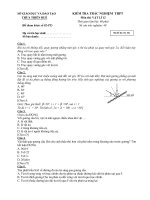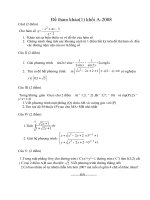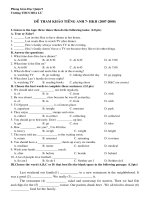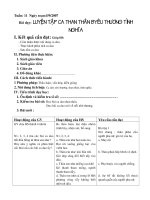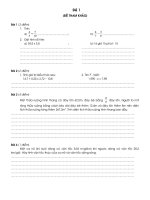JGH giunipero de tham khao
Bạn đang xem bản rút gọn của tài liệu. Xem và tải ngay bản đầy đủ của tài liệu tại đây (22.3 KB, 4 trang )
Key Skill Sets for the Purchasing Manager of the Future
Robert B. Handfield, Ph.D.
Bank of America University Distinguished Professor of SCM
Director, Supply Chain Resource Consortium
College of Management
North Carolina State University
(919/ 515 4674);
Larry Giunipero, Ph.D.
Professor of Supply Management
Florida State University
89th Annual International Supply Management Conference, April 2004
Abstract: The objective of this study was to ascertain the state of purchasing/supply education
and training as it currently exists and forecast what changes are coming in the next five years.
This includes the perceived needs for training, the types of training being pursued by
Purchasing/Supply Management personnel and the contexts within which training is planned
and delivered. The results of the study suggest that the pressure to reduce costs across
industries is increasing. In response, however, purchasing executives will seek managers who
possess skills in management of supplier relationships, improved communication and
presentation skills, knowledge of ethics, and ability to effectively manage the end to end supply
chain through improved business acumen and an understanding of the “big picture” from a
strategic perspective.
Purchasing Education and Training (PET) are vital to the success of the organization and to
the survival and growth of the profession. Since the completion of the previous PET study in
1993 there have been dramatic impacts upon and changes within the field of
purchasing/supply management. Examples, but not limited to, are: 1) changing nature of
supplier relationships and alliances; 2) the growth and use of the Internet to facilitate
eProcurement; 3) significant reductions in purchasing staffs; 4) focus on strategic goals related
to cost/value; 5) the evolution of supply chain management as an integrated competitive
business strategy, and the contribution of purchasing to this strategy; 6) a shift from basic
purchasing to more strategic supply management.
There is also increasing anecdotal evidence that many of the Chief Purchasing Officers
(CPOs) of this decade are being assigned from outside the purchasing and supply field. These
appointments bring with them two strong implications: a) senior management want different
things from the purchasing/supply management groups than they perceive would be obtained
by promoting from within, and b) these new people appear to be appointed with short term
employment contracts/agreements and have defined missions for change that must be
accomplished in a defined period. These conditions comprise the landscape within which
traditional purchasing and supply personnel are operating in today. It is appropriate to revisit
the realm of purchasing education training in the new millennium in the context of this
changing environment.
Research Approach:
The insights found in this paper were taken from the participant’s feedback and discussion
during four regional focus groups. The top executives of 41 companies within the Boston,
Phoenix, Raleigh, and Kansas City metropolitan areas attended the focus groups in 2002. The
primary researchers conducted the focus groups. The intent of these focus groups was to gain
information about the type of training and education requirements that are needed for supply
managers of the future, based upon what the represented companies believed to be the trends
of purchasing and supply management.
Results:
From the focus groups, a number of different trends came out during discussions. Some of the
findings included, but were not limited to: 1) the evolving character of supplier relationships
and alliances, 2) the growth of the Internet to facilitate e -Procurement, 3) the use of strategic
initiatives to further reduce cost and gain value, 4) greater integration of the procurement
strategies with the competitive business strategy of the company, and 5) a transition from
tactical purchasing to more strategic supply management.
The responses of the executi ves were combined into two major categories: ‘Problems, Trends,
and Challenges’ and ‘Training Requirements’. Each category resulted in a number of notable
areas. The notable areas of each category were tabulated across all four focus groups to
determine the Top 10 Trends and Top 10 Training Requirements of Purchasing and Supply
Executives. The following table shows the top responses for Future Trends:
Top Problems, Trends,
Challenges
Total
References
Raleigh
Phoenix
Boston
Kansas
Strategic Relationship
Management with
Suppliers
53
22
10
15
6
Strategic Cost Reduction
49
15
6
11
17
Increasing Process Focus
34
8
7
5
14
Services-Based Suppliers
– Need Experts
31
6
3
5
17
Larger Relationships With
Customers and Sales
Teams
28
8
7
8
5
Greater Focus on Supplier
Selection
27
7
9
2
9
Global Purchasing
25
10
5
2
8
E-Procurement
23
6
3
7
7
More Industry -Specific
Training and Professional
Certifications
21
11
2
8
0
Big Picture (Strategic)
Focus
27
7
5
5
10
From the focus groups, a number of different training requirements came out during
discussions. Some of the findings included, but were not limited to: 1) a need for more
exposure to risk mitigation and legal issues within domestic and global environments, 2) better
presentation and overall communication skills across employee levels, 3) an understanding of
the concerns with using ERP systems, 4) new uses for e-Procurement, for example reverse
auctioning online, and 5) business strategy skills.
The following table shows the top responses for training requirements:
Top Training Requirements
Total
References
Raleigh
Phoenix
Boston
Kansas
Effective Presentation SkillsNegotiating, Problem-Solving, and
General Communications
33
19
5
8
1
Business Ethics
33
8
5
14
6
Global Diversity
27
13
5
4
5
Broader Business Skills
26
11
4
9
2
ERP Systems Implementation and
Integration
26
6
6
9
5
Project Management
26
13
6
3
4
Leadership and Conflict Resolution
24
4
4
8
8
E-Procurement - Reverse
Auctioning and Supply Market
Research
22
13
5
2
2
Planning & Strategy
16
9
0
1
6
Legal Contract Writing and Risk
Mitigation
12
9
0
0
3
Summary of Results
Many things are changing in the world of purchasing. It is maturing from its older, tactical ways
to evaluating new ventures and strategic supplier selection using a big picture focus. Suppliers
will be assessed to a greater degree on their current capabilities and ability to fit into the
company’s customized procurement strategy. Relationship management will become even
more important within the Supply managers role as greater input from suppliers will be
required during the early cycles of product development.
Creativity of suppliers, a supplier’s willingness to invest resources to further company
objectives, as well as overall ability of the supplier to reduce costs are a few of the determining
factors for supplier selection of the future. Supply management will not be just about bringing
parts in anymore. It will be about co-development with suppliers and sharing resources to
reduce costs end-to-end. Suppliers will be required to assess and align their current
capabilities and be more of a team player in cost assessment to keep up with the pace of
global competition.
Purchasing teams will leverage internal functions more and manage external relationships
better to create the most competitive supply chain strategy for their enterprise, and ideally
within their industry. Leveraging internal functions will require a greater integration of sales and
marketing, and more cross-functional and upper-management communication i n order to make
business decisions that align with the corporate strategy.
The two primary drivers that will continue to drive the purchasing arm of companies are cycle
time reduction and cost over time – which includes cost of poor quality. At the end of the day,
both are needed to get the products to market quicker.
These requirements will require a new set of skills for purchasing managers of the future.
Basic skills for understanding the elements of a company’s P&L, balance sheet, and cash flow
will be essential, as well as being able to integrated this understanding into the decision
making process in purchasing situations. Associates are expected to be able to nail down the
fundamental basics of business. For example, associates must be able to answe r questions
such as “What's going on in your business? Who are your competitors? What are they doing
as well as the supply base that you're responsible for?”
Corporations will also be looking for new hires that possess a strong knowledge within a
particular industry in addition to basic knowledge of how the supply chain works. Specialized
knowledge for a particular industry will create better negotiations when communicating with
suppliers. Furthermore, the ideal candidate will have a number of certifications under her belt.
In contrast to hard skills, soft skills are also needed. The ability to actively listen, communicate
effectively, build teams, readily adapt, persuade people, sell the benefits of purchasing
involvement, effective time management, and selling a common vision to internal customers
are very important to enable the supply management profession to respond appropriately to
changing client environments. International awareness of business and cultural norms in
foreign countries is also becoming more of a job requisite.
When it comes down to it, success relies on purchasers’ ability to come up with innovative
ways of doing things and placing people in the top positions that will look for new ways to
make a positive difference- whether it is saving on costs or inventing a new way for capitalizing
on suppliers strengths.
